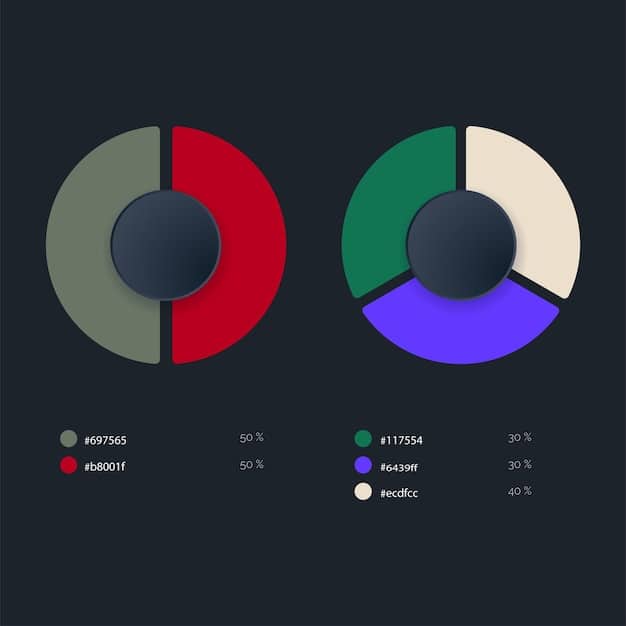Evaluating the Accuracy of Data Visualizations in News Reporting

Anúncios
Evaluating the accuracy of data visualizations in news reporting involves employing critical assessment techniques to ensure graphical representations of data are truthful, unbiased, and accurately reflect the underlying information to prevent misinterpretation and inform public understanding.
Anúncios
In the realm of modern journalism, data visualizations have become increasingly vital in conveying complex information concisely and engagingly. However, the power of these visuals comes with the responsibility of ensuring their accuracy. This article delves into evaluating the accuracy of data visualizations in news reporting, exploring methods, potential pitfalls, and best practices.
The Growing Importance of Data Visualizations
Data visualizations play a crucial role in modern news reporting, transforming complex datasets into accessible and digestible formats. This allows news outlets to present intricate information in a way that engages a broader audience and enhances understanding.
Anúncios
However, the increasing reliance on data visualizations also highlights the potential for misrepresentation and distortion. Ensuring the accuracy of these visuals is paramount for maintaining journalistic integrity and public trust.

Enhancing Understanding Through Visuals
Visual representations of data offer several advantages over traditional text-based reporting. They can quickly convey trends, patterns, and relationships that might be difficult to grasp from raw numbers alone.
- Accessibility: Visuals can make data more accessible to a wider audience, including those who may not have a background in statistics or data analysis.
- Engagement: Well-designed visualizations can capture attention and make the news more engaging, encouraging readers to explore the data further.
- Clarity: Visuals can simplify complex information, highlighting key insights and reducing the cognitive load on the reader.
Ultimately, data visualizations enable news organizations to communicate more effectively and impactfully, but only if they are accurate.
The significance of data visualizations in news reporting is undeniable, provided they are grounded in accuracy and ethical presentation.
Understanding Common Pitfalls in Data Visualization
Creating effective and accurate data visualizations requires careful attention to detail. Several common pitfalls can lead to misrepresentation and distortion, undermining the integrity of the news.
Recognizing these pitfalls is the first step in evaluating the accuracy of data visualizations in news reporting and ensuring that readers receive reliable information.
Scaling and Axis Manipulation
One of the most common ways data visualizations can be misleading is through the manipulation of scales and axes. Truncating the y-axis, for example, can exaggerate differences between data points, making small changes appear significant.
Similarly, using inconsistent scales or selectively choosing the range of values displayed can create a distorted picture of the underlying data.
Cherry-Picking Data
Another pitfall is the selective presentation of data to support a particular narrative. This involves choosing only the data points that align with a desired conclusion while ignoring those that contradict it.
- Context Matters: Cherry-picking data can lead to a biased and incomplete understanding of the issue at hand.
- Transparency is Key: It’s essential to present data in its full context, including any limitations or caveats.
- Ethical Considerations: Journalists must avoid manipulating data to push a specific agenda.
Presenting a fair and balanced view of the data requires avoiding cherry-picking and providing complete information.
By understanding and avoiding these pitfalls, news organizations can create more accurate and trustworthy data visualizations.

Methods for Evaluating Data Visualization Accuracy
Evaluating the accuracy of data visualizations involves a multi-faceted approach that combines technical expertise with journalistic integrity. Several methods can be employed to ensure that visuals accurately reflect the underlying data.
These methods are crucial for upholding the standards of evaluating the accuracy of data visualizations in news reporting and providing readers with reliable information.
Cross-Referencing Data Sources
One of the most effective ways to verify the accuracy of a data visualization is to cross-reference the data with multiple independent sources. This helps identify any discrepancies or inconsistencies that may indicate errors or manipulation.
- Independent Verification: Comparing data from different sources can reveal potential biases or inaccuracies.
- Source Reliability: Assess the credibility and reliability of the data sources used in the visualization.
- Triangulation: Use multiple sources to confirm the accuracy of the data presented.
By cross-referencing data sources, journalists can strengthen the credibility of their data visualizations.
Statistical Analysis
Statistical analysis can provide valuable insights into the accuracy and validity of data visualizations. This involves examining the data for outliers, anomalies, and other statistical irregularities that may indicate errors or manipulation.
Employing statistical methods to assess the data visualization’s integrity ensures that there are no discrepancies.
Statistical analysis is a powerful tool for ensuring that data visualizations accurately reflect the underlying data.
Using these methods, news organizations can ensure the accuracy and reliability of their data visualizations.
Ensuring Ethical Data Visualization Practices
Ethical data visualization goes beyond simply avoiding technical errors. It involves considering the potential impact of the visualization on the audience and taking steps to ensure that it is presented in a fair and unbiased manner.
Adhering to ethical practices is fundamental to evaluating the accuracy of data visualizations in news reporting and maintaining public trust.
Transparency and Disclosure
Transparency is a cornerstone of ethical data visualization. This means clearly disclosing the sources of the data, the methods used to create the visualization, and any limitations or caveats that may affect its interpretation.
Providing this information allows readers to assess the credibility of the visualization and make informed judgments about the data.
Avoiding Sensationalism
Data visualizations should be presented in a way that avoids sensationalism and exaggeration. This means resisting the temptation to use misleading scales, cherry-pick data, or create visuals that are designed to evoke an emotional response rather than inform.
Journalists should strive to present data in a neutral and objective manner, allowing readers to draw their own conclusions.
Presenting data in a measured way helps to avoid sensationalizing the information in the news.
By adhering to these principles, news organizations can ensure that their data visualizations are both accurate and ethical.
The Role of Technology in Accurate Visualizations
Technology plays an increasingly important role in the creation and evaluation of data visualizations. Various tools and techniques can help journalists ensure the accuracy and integrity of their visuals.
Leveraging technology effectively is essential for evaluating the accuracy of data visualizations in news reporting in the digital age.
Data Visualization Software
Specialized data visualization software can automate many of the tasks involved in creating accurate and effective visuals. These tools often include built-in checks and balances to prevent common errors and ensure data integrity.
Examples include Tableau, Power BI, and Datawrapper, which offer features such as data validation, automated scaling, and customizable chart templates.
Automated Error Detection
Automated error detection tools can help identify potential inaccuracies in data visualizations. These tools use algorithms to detect outliers, anomalies, and other statistical irregularities that may indicate errors or manipulation.
By automatically flagging potential issues, these tools can save journalists time and effort while improving the accuracy of their visuals.
Automated tools can check the data visualization for issues that stem from manipulated data or human error.
By utilizing technology effectively, news organizations can enhance the accuracy and impact of their data visualizations.
Case Studies: Analyzing Data Visualization Accuracy in News
Examining real-world examples of data visualizations in news reports can provide valuable insights into the challenges and best practices of ensuring accuracy.
These case studies illustrate the importance of evaluating the accuracy of data visualizations in news reporting and the potential consequences of failing to do so.
Example 1: The Misleading COVID-19 Curve
During the early stages of the COVID-19 pandemic, many news outlets published visualizations of the infection curve to illustrate the spread of the virus.
However, some of these visualizations used misleading scales or cherry-picked data, creating a distorted picture of the pandemic’s trajectory. In some cases, the y-axis was truncated to exaggerate the rate of increase, while in others, data from different countries or regions were combined in a way that obscured important differences.
Example 2: Climate Change Data
Data visualizations are often used to communicate the impacts of climate change, such as rising sea levels and increasing global temperatures.
However, these visualizations can be misleading if they fail to account for uncertainties or present data in a biased manner. For example, a map showing the extent of sea-level rise may use overly optimistic or pessimistic projections, leading to an inaccurate portrayal of the potential impacts.
Real-world examples show how data can be easily influenced to tell a narrative instead of facts.
Analyzing these case studies underscores the importance of critical evaluation and ethical presentation in creating accurate data visualizations.
| Key Aspect | Brief Description |
|---|---|
| 📊 Accuracy Evaluation | Critical for avoiding misinterpretations in news. |
| 🤔 Common Pitfalls | Includes scale manipulation and selective data use. |
| 🔎 Verification Methods | Cross-referencing sources, statistical analysis. |
| ✅ Ethical Practices | Transparency and avoidance of sensationalism are crucial. |
Frequently Asked Questions
▼
Data visualization accuracy is crucial because it ensures that presented information is truthful and not misleading, fostering informed decisions and public trust in news reporting.
▼
Common manipulation methods include truncating axes, cherry-picking data, using misleading scales, and creating visualizations biased towards a specific narrative.
▼
Data sources can be verified by cross-referencing with independent sources, assessing source credibility, and employing triangulation methods to confirm data accuracy.
▼
Technology aids accuracy through specialized software that automates data validation and algorithms that detect anomalies and other irregularities indicative of manipulation.
▼
Sensationalism can be avoided by presenting data objectively, resisting the temptation to exaggerate, and allowing the audience to draw unbiased conclusions from neutral presentations.
Conclusion
Evaluating the accuracy of data visualizations in news reporting is essential for maintaining journalistic integrity and ensuring that the public receives reliable information. By understanding common pitfalls, employing rigorous evaluation methods, adhering to ethical practices, and leveraging technology effectively, news organizations can create data visualizations that inform, engage, and empower.





